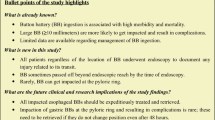Abstract
Background
Recent studies have shown an increase in morbidity associated with button battery ingestions in children.
Objective
To perform a comprehensive, imaging-focused review of all patients with confirmed button battery ingestions/insertions imaged at our institution in the last 15 years.
Materials and methods
Radiology reports from Jan. 1, 2000, to July 12, 2015, were searched for the terms “battery” and “batteries.” Confirmed cases of battery ingestion/insertion for which images were available were reviewed. Cases were reviewed for imaging studies performed, imaging findings, patient demographics, clinical history and management. Two pediatric gastroenterologists reviewed endoscopic images and graded mucosal injuries in selected cases.
Results
Two hundred seventy-six cases were reviewed. All patients were imaged with radiography, 19 with fluoroscopy (6.8%), and 4 with CT (1.4%). Batteries retained in the esophagus (n = 27, 9.8%) were larger in diameter on average than those that had passed distally (22.1 ± 3.3 mm vs. 13.7 ± 1.6 mm, P<0.0001). Battery diameter ≥20 mm was associated with esophageal impaction (P<0.0001) and higher grade esophageal injury (P<0.0001). Mean battery diameter was greater for patients with grade 1 or higher mucosal injury than for patients with no mucosal injury (22.1 ± 2.1 mm vs. 14.7 ± 4.5 mm, P<0.0001). Sixteen percent (4/25) of patients with grade ≥1 esophageal injury had batteries in the stomach on initial imaging. Five patients (1.8%) had serious clinical complications (e.g., esophageal perforation, tracheoesophageal fistula).
Conclusion
Button batteries >20mm in diameter warrant increased clinical scrutiny due to higher likelihood and severity of injury. Implementation of recent pediatric gastroenterology societal guidelines will likely lead to a substantial increase in the number of CT and MRI examinations.





Similar content being viewed by others
References
Votteler TP, Nash JC, Rutledge JC (1983) The hazard of ingested alkaline disk batteries in children. JAMA 249:2504–2506
Litovitz T (1983) Button battery ingestions. A review of 56 cases. JAMA 249:2495
Litovitz TL (1985) Battery ingestions: product accessibility and clinical course. Pediatrics 75:469–476
Litovitz T, Schmitz BF (1992) Ingestion of cylindrical and button batteries: an analysis of 2382 cases. Pediatrics 89:747–757
Thompson N, Lowe-Ponsford F, Mant TG et al (1990) Button battery ingestion: a review. Adverse Drug React Acute Poisoning Rev 9:157–180
Litovitz T, Whitaker N, Clark L (2010) Preventing battery ingestions: an analysis of 8648 cases. Pediatrics 125:1178–1183
Litovitz T, Whitaker N, Clark L et al (2010) Emerging battery-ingestion hazard: clinical implications. Pediatrics 125:1168–1177
Sharpe SJ, Rochette LM, Smith GA (2012) Pediatric battery-related emergency department visits in the United States, 1990–2009. Pediatrics 129:1111–1117
Jatana KR, Litovitz T, Reilly JS et al (2013) Pediatric button battery injuries: 2013 task force update. Int J Pediatr Otorhinolaryngol 77:1392–1399
Brumbaugh DE, Colson SB, Sandoval JA et al (2011) Management of button battery induced hemorrhage in children. J Pediatr Gastroenterol Nutr 52:585–589
Hamilton JM, Schraff SA, Notrica DM (2009) Severe injuries from coin cell battery ingestions: 2 case reports. J Pediatr Surg 44:644–647
Centers for Disease Control and Prevention (CDC) (2012) Injuries from batteries among children aged <13 years--United States, 1995–2010. MMWR Morb Mortal Wkly Rep 61:661–666
Kramer RE, Lerner DG, Lin T et al (2015) Management of ingested foreign bodies in children: a clinical report of the NASPGHAN Endoscopy Committee. J Pediatr Gastroenterol Nutr 60:562–574
Zargar SA, Kochhar R, Mehta S et al (1991) The role of fiberoptic endoscopy in the management of corrosive ingestion and modified endoscopic classification of burns. Gastrointest Endosc 37:165–169
Leinwand K, Brumbaugh DE, Kramer RE (2016) Button battery ingestion in children: a paradigm for management of severe pediatric foreign body ingestions. Gastrointest Endosc Clin N Am 26:99–118
Cetinkaya EA, Arslan İB, Cukurova İ (2015) Nasal foreign bodies in children: types, locations, complications and removal. Int J Pediatr Otorhinolaryngol 79:1881–1885
Guidera AK, Stegehuis HR (2010) Button batteries: the worst case scenario in nasal foreign bodies. N Z Med J 123:68–73
Bakshi SS, Coumare VN, Priya M et al (2016) Long-term complications of button batteries in the nose. J Emerg Med 50:485–487
Author information
Authors and Affiliations
Corresponding author
Ethics declarations
Conflicts of interest
None
Rights and permissions
About this article
Cite this article
Pugmire, B.S., Lin, T.K., Pentiuk, S. et al. Imaging button battery ingestions and insertions in children: a 15-year single-center review. Pediatr Radiol 47, 178–185 (2017). https://doi.org/10.1007/s00247-016-3751-3
Received:
Revised:
Accepted:
Published:
Issue Date:
DOI: https://doi.org/10.1007/s00247-016-3751-3




